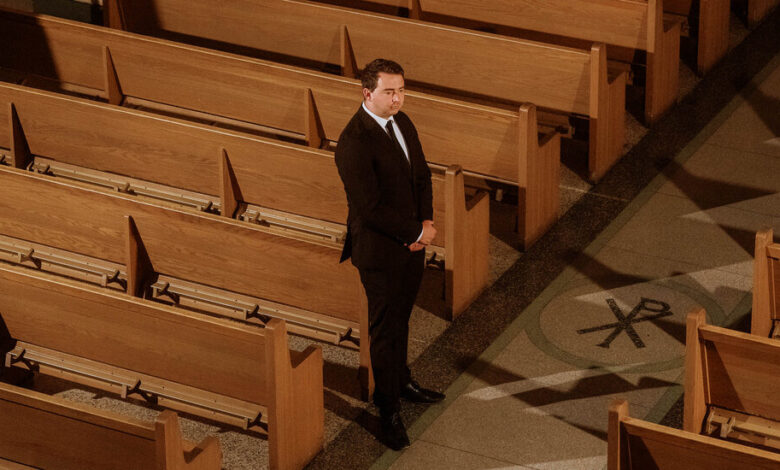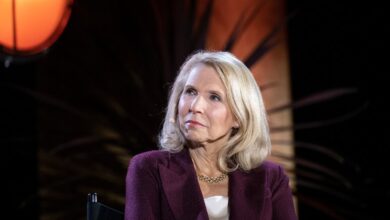Student Debt Is Standing in the Way of Future Nuns and Priests

It wasn’t until after college that Kendra Baker began to consider becoming a nun. She had been raised a Roman Catholic, and after her father fell from the roof of their home, suffering life-threatening injuries, her family called a priest to come and pray with them. A few hours later, her father opened his eyes.
“He’s relearned to walk, talk, drive — he can eat normally,” Ms. Baker, 25, said. “And doctors had told us to prepare for a funeral.”
That wasn’t the only experience that nudged Ms. Baker, who, after graduating from Western Washington University in 2021, moved to Seattle and started to feel a “gentle prompting” toward religious life. “Not God’s booming voice saying, ‘Kendra, go to the convent now.’ But just very gentle,” she said.
After much thought and research, Ms. Baker found a religious community that she felt aligned with her interests in both contemplative spirituality and active service, and she was soon accepted as a candidate with the Carmelite Sisters of the Most Sacred Heart of Los Angeles. Only one thing was preventing her from joining: her student loan debt.
People wishing to enter religious life in the Catholic tradition are typically required to pay off all their debts to prepare themselves to take a vow of poverty, and others living in religious communities usually don’t earn an income or own assets, preventing them from paying any debts they accrued as laypeople. If they’re among the 20 percent of Americans with undergraduate degrees who have student loan debt, it can pose significant challenges.
A report from the National Religious Vocation Conference signaled the alarm more than a decade ago with data that confirmed that “educational debt had become a deterrent for many discerning a religious vocation,” pointing to factors such as the ballooning cost of tuition and wage stagnation. Since then, the average student loan debt in the United States has grown steadily, reaching an average of about $30,000 in 2023.
Several organizations have emerged to help religious order candidates with this problem. Ms. Baker was put in touch with the Labouré Society, a nonprofit Catholic group that has helped more than 400 people enter religious formation since its inception in 2003.
The average student loan amount of Labouré candidates, or aspirants, is nearly $100,000, and they are typically given a goal of raising $60,000 in one six-month cycle during which Labouré facilitators train them on how to make phone calls, write letters and take meetings with potential donors in their communities. Donations have ranged from a few thousand dollars to $130,000 from a retired widow who felt inspired to give the proceeds from the sale of her home.
Ms. Baker said that she wasn’t comfortable sharing the full amount of debt she had but that it would have taken her five to 10 more years to pay it off if she hadn’t found help through the Labouré Society. Instead, she reached her goal within six months and will join her religious community in Los Angeles this summer.
Jake Smith had already completed three years of medical school when he decided he wanted to join the priesthood. He is the second oldest of 12 children in what he described as a “salt of the earth, light of the world Catholic family,” and remembers having an early prompting toward a religious calling when he was 14.
Having grown up hoping he would one day get married and have a family, Mr. Smith, 31, felt conflicted and tried his best to avoid the idea of joining the priesthood for as long as he could.
“When I got accepted to medical school,” he said, “I felt like I kind of threw down my acceptance letter in front of God, and I was like: ‘OK, God, there’s no way you’re ever going to get me now. I’m going to be the best doctor you’ve ever had. I’m going to be the best dad in the whole world. So just leave me alone with all this vocation stuff.’”
But three years into his medical studies in Denver, after a day spent in a family medicine rotation, he found his thoughts again drifting to the priesthood and what he might include in his first homily.
“I realized that this was something that was never ever going to go away,” Mr. Smith said. After consulting with a priest at his church and speaking with a vocations director in his diocese, he began to realize his student loan debt — in the low six figures — was a significant obstacle.
Diocesan priests, unlike those living in religious communities, typically earn a modest stipend and are sometimes allowed to carry a small amount of debt before entering a seminary. But for people like Mr. Smith, significant student loan debt can delay their entrance into the priesthood for years, or even indefinitely.
Mr. Smith hopes to clear his student loans through the Labouré Society in the next 12 to 18 months and has already raised just under $60,000 by soliciting donations from local Catholics and talking with people interested in supporting religious vocations.
For those who may not have as widespread a Catholic network, fund-raising might take a different form.
Kristen Chenoweth converted to Catholicism from Lutheranism in her mid-20s and did not have longstanding connections or family ties to the Catholic Church. After completing an undergraduate degree in family ministry and a master’s degree in nonprofit administration, Ms. Chenoweth, now 30, had around $80,000 in student loan debt. She was accepted into the Dominican Sisters of the Immaculate Conception Province in Illinois, but could not take her first steps into religious life until that debt was paid off.
She had started to pay down her loans by working, living frugally, fund-raising with her diocese in Grand Rapids, Mich., and selling rosaries on Etsy.
Ms. Chenoweth earned about $5,000 through her Etsy shop and, with the help of the Dominican Sisters, raised $23,000 on GoFundMe. More recently, she received news that another Catholic organization that provides student debt support, the Fund for Vocations, would pay the remainder of her loans, and she’ll join her religious community this summer.
Unlike the Labouré Society, the Fund for Vocations does not ask aspirants to raise money, instead paying their monthly student loan payments directly for the entire time they are in formation with a religious community.
The Fund for Vocations, founded in the early 2000s, has grown considerably in recent years to meet demand. The organization was able to distribute 28 grants totaling about $900,000 last year, in amounts ranging from about $5,000 to more than $75,000, depending on the needs of the applicants.
Young aspirants often deal with a drastically shortened period to repay their loans. Applicant age limits, as young as 30 in some religious orders, create additional pressures. And though many religious communities and seminaries do not require applicants to have college degrees, others encourage them or require them, especially if members provide health care or education services to the community.
Once they take final vows, those who enter religious life also enter into a whole new financial reality. For Sister Gianna Casino, living as a religious sister with the Leaven of the Immaculate Heart of Mary community and making her final vows in 2020 has given her a sense of financial freedom.
A former biochemistry major, Sister Gianna, 30, graduated with more than $20,000 in student loan debt. She started religious formation under an agreement that her family would cover her monthly payments and that it would be paid off before her final vows. When her family hit financial hardship a few years into her formation process, the Fund for Vocations agreed to pay off the remainder of her loans.
Now she has been able to pursue her education again, this time without fear of accruing more debt because her religious community covers her costs, including tuition. Sister Gianna is studying to be a clinical mental health counselor at Divine Mercy University and completed training at Harvard Medical School in mental health. Though obtaining the degree will be free, any income she earns once she graduates will be shared with her religious order.
While many religious communities are funded through donations or businesses, like the chocolates and candies sold by the members of Our Lady of the Mississippi Abbey in Dubuque, Iowa, some pool income that members such as nurses or educators earn from outside jobs.
“I’m able to study without anxiety or worry,” Sister Gianna said. “I’m able to focus on prayer, and spiritually, emotionally, physically and intellectually focus on the people that I’m going to serve in the next few years, and even now, because my community supports me in this way financially.”
Though the sacrifices can be significant, religious life can also offer a rare kind of liberation from the typical financial constraints and stressors that dictate most people’s lives.
“It brings me back to the Gospel of Luke,” Sister Gianna said. “Jesus says, ‘You cannot serve two masters. You can’t serve God and money.’”



